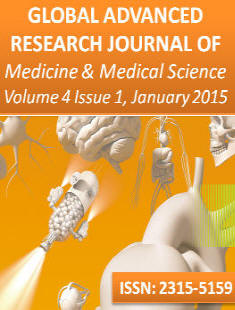|

January 2015 Vol. 4 Issue
1
Other viewing option
Abstract
•
Full
text
•Reprint
(PDF) (121 KB)
Search Pubmed for articles by:
Abu-Gharbia MA
El-Raheem WMA
Other links:
PubMed Citation
Related articles in PubMed
|
|
Global Advanced Research Journal
of Medicine and Medical Sciences (GARJMMS) ISSN: 2315-5159
January 2015 Vol. 4(1), pp.
021-027
Copyright © 2015 Global Advanced
Research Journals
Full Length Research Paper
|
Antibacterial effect of some Egyptian plants on
antibiotic-resistant oral bacteria
Magdy A. Abu-Gharbia, El-Sayed M. Soltan, Osman M.
El-Maghraby and Walaa M. Abd El-Raheem*
Department of Botany, Faculty of Science, Sohag
University, Sohag, Egypt
*Corresponding Author E-mail:
walaa123us@yahoo.com; Tel.:
+20934601159;
Fax: +20934601159
Accepted 02 January, 2015
|
|
Abstract |
|
The present study was conducted with a view to
evaluate the therapeutic potentials of six plants
traditionally used in Egypt against multi-drug
resistant oral pathogens isolated from infected
patients with different oral diseases. All ethanol
extracts of tested plants were found to exhibit
potential antimicrobial properties against
multi-drug resistant isolates but maximum zone of
inhibition was observed in ethanol extracts of
Allium sativum and Syzygium aromaticum
which
showed the minimum inhibitory concentration (MIC)
against Streptococcus mutans and
Staphylococcus aureus
to be 0.39 mg/ml. The antibacterial activities
observed could be due to the presence of some of the
secondary metabolites like, alkaloids,
anthraquinones, sterols, glycosides, saponins,
terpenes and flavonoids which detected in ethanol
extracts. The bioautographic results revealed that
the maximum zone of inhibition of Syzygium
aromaticum
and Allium sativum were observed at Rf
0.64 & 0.82, respectively which indicates that the
compound retained at these Rf
values having potent antibacterial efficacy against
the selected oral pathogens. The findings of present
study lend support for the use of them in
preparation of toothpastes and mouth rinses
containing these antimicrobial agents for the
prevention of oral microbial diseases.
Keywords:
plant extracts, antibacterial, minimum inhibitory
concentration (MIC),
phytochemical, bioautography.
|
| |
|
